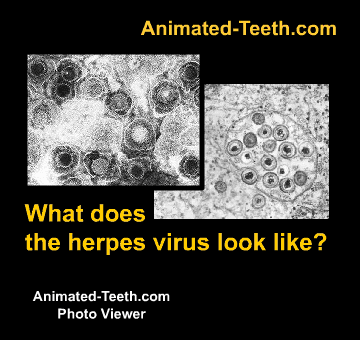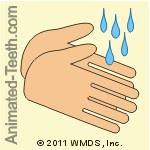Treating cold sores / fever blisters with prescription antiviral medications –
FDA approved antivirals.
- Denavir® 1% (penciclovir) – Topical cream.
- Zovirax® 5% (acyclovir) – Topical cream.
- Xerese® (acyclovir 5% and hydrocortisone 1%) – Topical cream.
- Valtrex® (valacyclovir) – Taken orally.
- Famvir® (famciclovir) – Taken orally.
How prescription antiviral cold sore medications work.
1) Topical applications.
The mode of action associated with the topical (ointment applied to sores) antiviral medications discussed on this page is one where they are used to interfere with the replication of the herpes virus (the production of more virus particles, which are called virions).

The herpes simplex virus.
a) Early application is key.
Initiating use at this stage is effective because at this point in the sore’s formation its rate of viral replication has not yet reached its peak, thus it can still be stifled.
In comparison, once a lesion has reached the Blister stage Description (the point of maximum viral presence) or beyond, the application will have no practical benefit because the bulk of virus production has already passed.
b) Topical medications are treatments, not a cure.
When topical antiviral preparations are used, a person should keep the following points in mind:
- These medicines are not a cure for cold sores/fever blisters. They only inhibit the replication of the virus, they do not eradicate it. The virus will still reside in your body Location | Details.
- The use of the medication will not prevent or have an effect on future cold sore outbreaks. The person’s risk of recurrence remains the same whether the medication was used or not.
- Even when a lesion is being treated with an antiviral, the risk of transmission of the herpes virus to others, or to other parts of your own body, remains and therefore all standard precautions should still be taken.
2) Systemic uses of prescription antivirals.
a) Treating cold sore outbreaks.
Historically, systemic (oral) antiviral medications have not routinely been used for the treatment of cold sores. However, short-course regimens of valacyclovir (Valtrex®) and famciclovir (Famvir®) do have FDA approval for this use and have been shown to accelerate lesion healing and decrease pain. (Cunningham)
In addition, the use of a systemic approach may be able to offer benefits that a topical application can’t provide.
b) Systemic antivirals may act as a preventive.
Short-term regimens of antiviral medication are sometimes effective as a cold-sore preventive for people who have known outbreak factors and are able to know in advance when they will be exposed to them.
c) Systemic antivirals may act as a suppressive.
▲ Section references – Neville, Cunningham
FDA approved topical antiviral medications.
Topical medicines for cold sores are those that are applied as an ointment or cream directly to the surface of the lesion. The FDA has given approval for 3 topical products for the treatment of cold sores: 1) Denavir® 1% (penciclovir). 2) Zovirax® 5% (acyclovir) and 3) Xerese® (acyclovir 5% and hydrocortisone 1%).
a) Denavir® cream 1% (penciclovir)
Denavir® cream was the first antiviral medication to be granted FDA approval for use in the treatment of cold sores. Approval was given in 1996.
Its instructions state that it should be applied repeatedly throughout the day every 2 waking hours (roughly 9 times a day) for 4 days on those external areas of the lips or face where the cold sore is forming. (Denavir® cream is not intended for internal use.)
Application of the cream should be started as soon as it’s sensed that a cold sore has begun to form (i.e., the Tingle stage).
b) Zovirax® cream 5% (acyclovir)
Zovirax® cream received FDA approval for use in the treatment of cold sores in late 2002, although other formulations of this medication have been used in treating herpes for many years (including an “off-label” use in the treatment of cold sores in the years prior to 2002).
It’s used in a similar fashion as with Denavir® cream. However, the dosing schedule is slightly more convenient (fewer applications per day).
The instructions for Zovirax® state that treatment should be started as soon it is sensed that a cold sore has begun to form (i.e., the Tingle stage). The cream is applied to those external areas of the lips or face where the cold sore is developing, 5 times a day for 4 days. (Zovirax® cream is not intended for internal use.)
c) Xerese® – (acyclovir [5%] and hydrocortisone [1%])
Xerese® cream is a combination product. It contains both an antiviral (acyclovir) and a steroid (hydrocortisone). It received FDA approval in 2009.
The cream is applied to the area where the cold sore is forming 5 times per day, for 5 days. (Xerese® cream is not intended for internal use.) As with other antiviral medications, early application is the key and is preferably started during the Tingle stage.
The idea with this product is that the steroid component helps to stifle the extent of the inflammation reaction that takes place in response to the presence of the virus particles and the destruction they have caused. By limiting this response, the size and severity of the lesion that forms are reduced.
Which is best? – Denavir® and Zovirax® vs. Xerese®
We think that the answer to this question is best answered by your health care professional. Having said that, research seems to suggest that the combination medication Xerese® (antiviral plus steroid) is more effective than just-antiviral medications.
- A study by Hull evaluated the use of an acyclovir (5%) and hydrocortisone (1%) cream (Xerese®). It found that the total area of the cold sore lesions that formed was 50% smaller than when no treatment was used. And 25% smaller than when just an antiviral cream (Zovirax®) was applied.
- A paper by Arain reviewed four studies that had evaluated the approach of combining topical antivirals and steroids in the treatment of cold sores (the approach used by Xerese®) and determined that this method was both as safe and more effective than treatment involving an antiviral cream alone (such as the use of Denavir® or Zovirax®).
Overall, healing times were the same for both treatment approaches. But combination treatment was less likely to result in cold sore ulcerative lesions (sores that advanced to the Weeping/Ulcer stage Description and beyond).
▲ Section references – Hull, Arain
Which is best? – Denavir® vs. Zovirax®
In regard to cases where the use of Xerese® isn’t applicable (i.e., patients with whom a steroid should not be used), we found several studies that evaluated the effectiveness of just antiviral treatment alone.
Zovirax®
Opstelten reviewed 10 studies that had evaluated the use of acyclovir cream (found in Zovirax®). Application of the prodcut was begun at the first sign of symptoms (the Tingle stage).
- All of the studies found that the time needed for cold sore healing was shortened (varying from 0.5 days up to 2.5 days reduction).
- None of the studies reported a decrease in the severity or duration of pain.
Denavir®
This same literature review stated that two penciclovir studies (the compound found in Denavir®) reported findings that were similar to those for acyclovir. However, one of these studies also reported a reduction in the duration of pain, by 0.5 days.
An edge for Denavir®.
▲ Section references – Opstelten, Femiano, Lin, McKeough, Neville

Always wash your hands after treating a cold sore.
Treating cold sores with topical applications – Best practices.
So to avoid spreading the herpes virus (either to other people or to other parts of your own body), after applying any medication or treatment to lesions you should always wash your hands.
FDA approved oral antiviral medicines.
This section discusses the systemic use of valacyclovir (Valtrex®) and famciclovir (Famvir®) in treating patients who suffer from cold sores.
Acyclovir also has a history of being used systemically. But valacyclovir and famciclovir offer the advantages of improved bioavailability (the proportion of the drug that enters the person’s circulation so to have an effect) and more convenient (less frequent) dosing schedules. (Neville)
a) Treating cold sore outbreaks.
A paper by Cunningham discusses the use of short-term, high-dose oral antiviral therapy to help to reduce cold sore duration and pain. The general idea is that taking a medication orally may be more convenient for the patient rather than performing topical applications.
Treatment regimens –
The paper cites the use of famciclovir (1500 mg as a single dose) OR valacyclovir (2 g every 12 hours for 1 day).
b) The use of prescription antivirals as a preventive.
This approach is sometimes taken with people who have known cold sore outbreak triggers View list., and are able to know when they will occur.
Examples –
People with scheduled dental treatment, an upcoming beach vacation (possible excessive sunlight exposure) or ski trip (potential for lip chapping) may find that taking an antiviral preemptively may help to subdue their normally anticipated breakouts (reduce their prevalence or severity).
Treatment regimens –
- The oral pathology textbook by Neville discusses the use of a regimen where two grams of valacyclovir are taken twice on the day of the person’s dental procedure and 1 gram is taken twice the next day in an attempt to suppress or minimize cold sore occurrence.
- This same source discusses the short-term prophylactic use of antivirals (like for the vacation scenarios mentioned above). It states a regimen involving acyclovir (400 mg twice daily), valacyclovir (1 g daily), OR famciclovir (250 mg twice daily) in an attempt to reduce cold sore prevalence or severity for these (short-term) periods.
c) Antivirals may be effective as a suppressive.
As opposed to short-term preventive use, long-term antiviral suppressive therapy is typically reserved for more problematic cases.
Treatment candidates.
It’s generally considered that the use of suppressive therapy is best reserved for situations where there’s a history of especially severe, frequent (6 outbreaks per year or more) or disfiguring lesions. Or cases involving persons who have a compromised immune system status.
The overuse/inappropriate use of this approach creates the potential for the development of viral resistance to the drug.
Treatment –
▲ Section references – Cunningham, Neville
Page references sources:
Arain N, et al. Effectiveness of topical corticosteroids in addition to antiviral therapy in the management of recurrent herpes labialis: a systemic review and meta-analysis.
Cunningham A, et al. Current management and recommendations for access to antiviral therapy of herpes labialis.
Femiano F,et al. Recurrent herpes labialis: Efficacy of topical therapy with penciclovir compared with acyclovir.
Hull CM, et al. Novel Composite Efficacy Measure To Demonstrate the Rationale and Efficacy of Combination Antiviral–Anti-Inflammatory Treatment for Recurrent Herpes Simplex Labialis.
Lin L, et al. Topical application of penciclovir cream for the treatment of herpes simplex facialis/labialis: a randomized, double-blind, multicentre, aciclovir-controlled trial.
McKeough MB, et al. Comparison of new topical treatments for herpes labialis.
Neville BW, et al. Oral and Maxillofacial Pathology. Chapter: Viral Infections.
Opstelten W, et al. Treatment and prevention of herpes labialis.
All reference sources for topic Cold Sores.